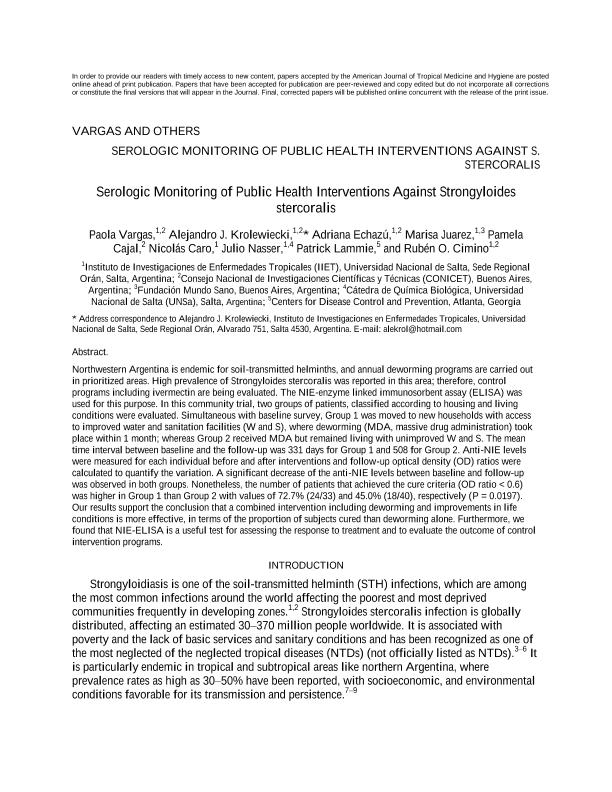Artículo
Serologic monitoring of public health interventions against strongyloides stercoralis
Vargas, Paola; Krolewiecki, Alejandro Javier ; Echazú, Adriana
; Echazú, Adriana ; Juarez, Marisa; Cajal, Silvana Pamela; Gil, José Fernando
; Juarez, Marisa; Cajal, Silvana Pamela; Gil, José Fernando ; Caro, Nicolas Dagoberto; Nasser, Julio Rubén; Lammie, Patrick; Cimino, Rubén Oscar
; Caro, Nicolas Dagoberto; Nasser, Julio Rubén; Lammie, Patrick; Cimino, Rubén Oscar
 ; Echazú, Adriana
; Echazú, Adriana ; Juarez, Marisa; Cajal, Silvana Pamela; Gil, José Fernando
; Juarez, Marisa; Cajal, Silvana Pamela; Gil, José Fernando ; Caro, Nicolas Dagoberto; Nasser, Julio Rubén; Lammie, Patrick; Cimino, Rubén Oscar
; Caro, Nicolas Dagoberto; Nasser, Julio Rubén; Lammie, Patrick; Cimino, Rubén Oscar
Fecha de publicación:
04/2017
Editorial:
American Society of Tropical Medicine and Hygiene
Revista:
American Journal of Tropical Medicine and Hygiene
ISSN:
0002-9637
Idioma:
Inglés
Tipo de recurso:
Artículo publicado
Clasificación temática:
Resumen
Northwestern Argentina is endemic for soil-transmitted helminths, and annual deworming programs are carried out in prioritized areas. High prevalence of Strongyloides stercoralis was reported in this area; therefore, control programs including ivermectin are being evaluated. The NIE-enzyme linked immunosorbent assay (ELISA) was used for this purpose. In this community trial, two groups of patients, classified according to housing and living conditions were evaluated. Simultaneous with baseline survey, Group 1 was moved to new households with access to improved water and sanitation facilities (W and S), where deworming (MDA, massive drug administration) took place within 1 month; whereas Group 2 received MDA but remained living with unimproved W and S. The mean time interval between baseline and the follow-up was 331 days for Group 1 and 508 for Group 2. Anti-NIE levels were measured for each individual before and after interventions and follow-up optical density (OD) ratios were calculated to quantify the variation. A significant decrease of the anti-NIE levels between baseline and follow-up was observed in both groups. Nonetheless, the number of patients that achieved the cure criteria (OD ratio < 0.6) was higher in Group 1 than Group 2 with values of 72.7% (24/33) and 45.0% (18/40), respectively (P = 0.0197). Our results support the conclusion that a combined intervention including deworming and improvements in life conditions is more effective, in terms of the proportion of subjects cured than deworming alone. Furthermore, we found that NIE-ELISA is a useful test for assessing the response to treatment and to evaluate the outcome of control intervention programs.
Palabras clave:
Strongyloides Stercoralis
,
Serologic Monitoring
,
Public Health
Archivos asociados
Licencia
Identificadores
Colecciones
Articulos(INENCO)
Articulos de INST.DE INVEST.EN ENERGIA NO CONVENCIONAL
Articulos de INST.DE INVEST.EN ENERGIA NO CONVENCIONAL
Articulos(IPE)
Articulos de INST.DE PATOLOGIA EXPERIMENTAL
Articulos de INST.DE PATOLOGIA EXPERIMENTAL
Citación
Vargas, Paola; Krolewiecki, Alejandro Javier; Echazú, Adriana; Juarez, Marisa; Cajal, Silvana Pamela; et al.; Serologic monitoring of public health interventions against strongyloides stercoralis; American Society of Tropical Medicine and Hygiene; American Journal of Tropical Medicine and Hygiene; 97; 1; 4-2017; 166-172
Compartir
Altmétricas



